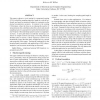Free Online Productivity Tools
i2Speak
i2Symbol
i2OCR
iTex2Img
iWeb2Print
iWeb2Shot
i2Type
iPdf2Split
iPdf2Merge
i2Bopomofo
i2Arabic
i2Style
i2Image
i2PDF
iLatex2Rtf
Sci2ools
ICASSP
2011
IEEE
2011
IEEE
Short and smooth sampling trajectories for compressed sensing
This paper explores a novel setting for compressed sensing (CS) in which the sampling trajectory length is a critical bottleneck and must be minimized subject to constraints on the desired reconstruction accuracy. In contrast to the existing CS literature, where the focus is on reducing the number of measurements, this contribution describes a short and smooth sampling trajectory guaranteed to satisfy the Restricted Isometry Property if the underlying signal is sparse in an appropriate basis. A na¨ıve path based on randomly choosing a collection of sample locations and using a Traveling Salesman Problem solver to choose a “short” trajectory is shown to be dramatically longer than the nearly straight and very smooth path proposed in this paper. Theoretical justification for the proposed path is presented, and applications to MRI, electromagnetics, and ecosystem monitoring are discussed.
ICASSP 2011 | Restricted Isometry Property | Signal Processing | Smooth Sampling Trajectory | Traveling Salesman Problem |
Related Content
| Added | 21 Aug 2011 |
| Updated | 21 Aug 2011 |
| Type | Journal |
| Year | 2011 |
| Where | ICASSP |
| Authors | Rebecca M. Willett |
Comments (0)

